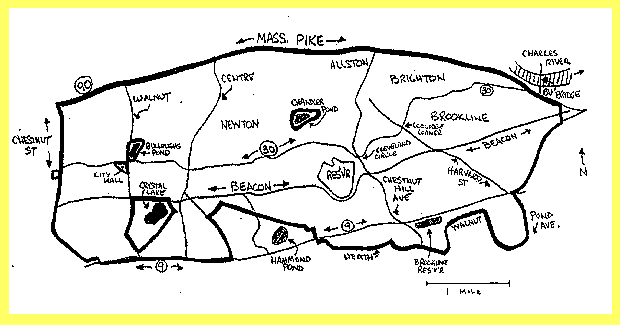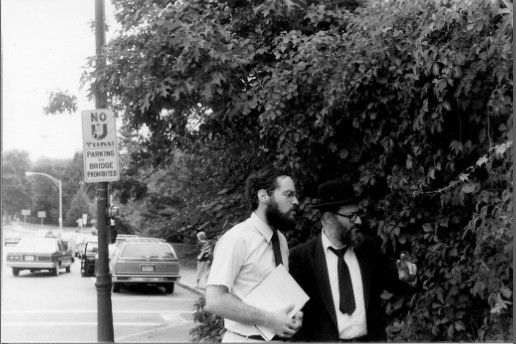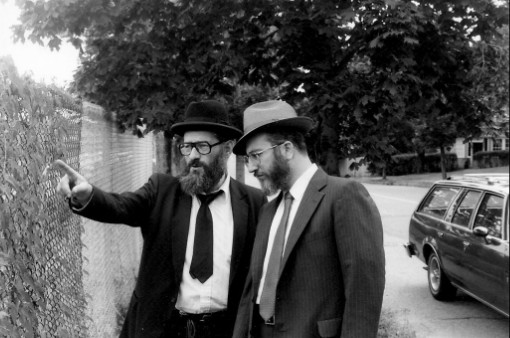Boston Eruv History
Introduction
Purpose
Historical
Concept
Community Impact
Strategy
|
The Greater Boston Eruv Corporation was legally brought into existence during the Summer of 1985. This event marks but one significant step in a process that began in earnest in the Fall of 1984 and has been in constant, forward motion since that time until the present. The goal of this Corporation is to design, develop, build, and maintain an "Eruv" (pronounced 'ay-roov') district extending over parts of the Boston, Brookline, and Newton Jewish communities. The Sabbath of the Jew is a very special time of the week. From Friday evening just prior to sunset until Saturday evening when the stars begin to appear, a spirit of calm and restfulness descends which contrasts with the fast pace of daily weekday life. For the traditional Jew, the Sabbath, like all other aspects of life, is defined by a complete set of legal guidelines which describe the "do's" and "don't's" of the day. Among the restrictions accepted by traditional Jews are the prohibitions of carrying objects from public domains to private domains and vice versa, and the carrying within a public domain. By public domains are meant non-residential areas including streets, thoroughfares, plazas ("open areas"), highways, etc. By private domains are meant residential areas such as homes and apartments, i.e. enclosed areas, and areas which are surrounded by a "wall" and can be deemed to be "closed off" from the surrounding public domains. Within these latter areas, one is permitted to carry. The purpose of an Eruv is to integrate (the Hebrew word "eruv" means to mix or join together) a number of private and public properties into one larger private domain. Consequently, individuals within the Eruv district are then permitted to move objects across, what was before the erection of the Eruv, a public domain-private domain boundary. Thus, one may then carry from ones' home to the sidewalk and then, for example, to someone else's home. This practice of constructing an Eruv has been used in countless Jewish communities throughout the world for over 2000 years. The legal principles involved fill entire volumes of the Babylonian and Jerusalem Talmuds (Codes of Jewish Law dating back to the first century C.E.). In our days, Eruvin (plural of Eruv) may be found in many cities around the world, large and small, including Paris, Jerusalem, Baltimore, Cleveland, New York, Los Angeles, Miami, East Brunswick and Teaneck (NJ), Riverdale, Pelham Parkway, Brooklyn, and Kew Gardens (NY), Stamford and Hartford (CT) and Sharon (MA). See the Eruv Links page for a more expanded listing.

The first handwritten map of the Boston Eruv - late 1980s The principle of Eruv is based upon enactments of the Rabbis of ancient times dealing with the subject of moving objects from one domain to another during the Sabbath. The principle states that it is prohibited to move any object from a certain domain in which it is located to another domain. This idea extends the concept of "rest" which forms an important foundation of the Sabbath day. Cessation from "work" on the Sabbath has various forms including cessation from labor, i.e. not performing those activities of the weekdays in which one makes and forms things (weekday work in all its variety). In addition, this cessation from work generates as a result a certain degree of restfulness and quietude. The cessation from the hustle and bustle of the weekdays and the cessation from the moving of objects from private to public domains has the effect of transforming public areas to areas of relative quiet and calm during the Sabbath day. In order to maintain such an atmosphere on the Sabbath day, the ancient scholars of the Jewish world established various legal principles relating to domains, both private and public. In order to consider an area a private domain, an important requirement must be fulfilled. If this requirement is met, carrying is permitted within that area. In order to qualify as a private domain, the area must cover at minimum an area of about 12 square feet and must be somehow demarcated from its surroundings, either by a wall of some sort or by virtue of its topography (that is, either the area is all higher or all lower than its surroundings). It is certainly impractical to consider erecting a solid, continuous, metal, stone, or wooden wall around portions of a city, crossing streets, sidewalks, etc. There is, in fact, a straightforward alternative. The conceptual basis for this alternative begins with the definition of a "doorway". A common doorway is comprised of two parts, the two doorposts on each side (the vertical members) and the lintel (the horizontal member). If one considers a wall separating two rooms in a house, it is certainly reasonable to say that even though a doorway opening exists in a wall (say between a living room and dining room), that the solid portion extending on each side of the opening is still a wall. Now, if additional doorway openings are placed in the wall, one may still maintain that the wall is still a wall, it merely has a lot of open space in it. In the limiting case, which is the case critical to the construction of an Eruv in a modern city, the "wall" can be thought of as being comprised of a wall containing many doorway openings and having very little of the solid wall remaining. In this case, the door post function can be fulfilled by telephone (utility) poles (the vertical members) and the lintel requirement can be met (generally) by existing cables strung between the poles. Thus, if the enclosure necessary for the Eruv can utilize existing utility (telephone/electric/cable) poles and their associated wires, and, in addition, existing natural boundaries and fences, then an appropriate perimeter may already be definable and may serve as a basis for the erection of an Eruv boundary. An additional complication exists in the straightforward use of existing utility equipment, etc. For a door post/lintel (utility-pole/cable) combination to be acceptable, the lintel must rest (as it does in common doorways) directly above the top of the doorposts. In contrast, the usual situation encountered in the utility-pole/cable case is that the cable is attached to the side of the pole. Thus, in order for the doorway/lintel comparison to be valid, a "pseudo"-door post must of necessity be placed under the utility pole cable. A thin rod (which can be any material as long it it is sturdy, generally a stiff plastic composition) can be attached onto the pole to serve as the door post "surrogate" (the Hebrew term for this rod is "lechi"). In actual practice, this rod is usually of sufficient length to facilitate its precise alignment with the cable overhead. (An additional practical reason for the attachment of such a rod is to signify to passersby when they are leaving and entering the Eruv district.) Finally, the cable or twine used as the lintel is usually the lowest line of the lines that may be attached to the side of any particular pole. If it is not, then it is necessary to string a new length of twine (usually made out of strong, thin plastic cable) between the affected set of poles. (Almost always, the existing wires are in the appropriate place thus requiring no additional stringing of twine.) In areas where the poles and lines do not exist, for example, in an area somewhat distant from a residence, or where the cabling is buried, new pole/twine combinations must be erected. These added poles must of course be sufficiently high so as not to impede traffic, etc. and must meet any and all legal codes. (In some cities, retired utility poles [telephone or light] have been acquired and used for this purpose.) If fences already exist along certain stretches of the perimeter, they may be used as part of the boundary without modification (i.e. they are technically used as "free" perimeter). A final consideration regarding fences relates to the condition of the ground beneath them. Whereas in the case of the rod attachment to the utility pole, one may invoke a Jewish legal principle which basically states that one can assume that even though the rod may not extend all the way up and physically touch the overhead line, one can assume that the rod does (assuming that the rod tip is still precisely aligned beneath the overhead line) this presumption is not allowed to operate in the "downwards" direction. Thus, if the earth is eroded beneath the fence to any significant degree, the space must simply be filled in (with additional dirt, a wooden board, etc.). All the areas to be enclosed by the means described in general terms above must be "residential areas," or areas suitable for residential areas. Specifically, two areas which do not meet these criteria are (1) bodies of water, including lakes, streams, and ponds (reservoirs currently in use as drinking water sources are permitted without modification), and (2) cemeteries. These areas must be "closed-off" (encircled) from the Eruv domain or the Eruv area is rendered unfit for use. In some cases, for example, the Chestnut Hill Reservoir (operated by the MDC), a continuous fence already exists which effectively cordons off the lake from the proposed Eruv domain. In the case of Hammond Pond (Newton) , the Eruv perimeter can simply skirt the lake, while in the case of Crystal Lake (Newton), a system of utility poles and lines can be used to completely encircle the Lake, thus sealing it off from the Eruv domain. The question may be raised: what tangible changes occur as a result of having an Eruv in Boston? As mentioned above, traditional Jews are prevented, in the absence of an Eruv, from carrying anything outside of one's home during the Sabbath. This restriction is extremely hard on Jewish community and family life, since, for example, families with very young children who are not yet able to walk are "house-bound," unable to get either to synagogue or to friends' homes. An Eruv permits the use of strollers and walkers. It permits parents of young children to reach a synagogue on the Sabbath, to meet with friends at neighborhood homes, and to share a festive Sabbath meal together. Another population benefitting from the Eruv district is the elderly whose use of canes, wheelchairs, and other ancillary items is now possible. The Eruv facilitates greater involvement of the disabled population, in general, into the community on the Sabbath. Further, and very importantly, it will encourage greater interaction among the members of the larger Jewish community (notably by allowing more inter-family contact and at greater distances than are presently possible). As more Eruvin are constructed in cities across the United States, the absence or presence of an Eruv has become an issue in one's decision to move to a new location (especially if the area in which one is presently residing has an Eruv and the city to which one might consider relocating does not). Thus, the erection of the Greater Boston Eruv assists the traditional Jewish community of Boston, long a highly visible and supportive constituency to the greater Boston community, in continuing to attract young traditional, Jewish professionals who will add strength and a future to their communities and neighborhoods. Finally, it is important to note that the erection of this Eruv in no way abrogates the rights of any individual in the greater Boston public living within its borders. Besides the presence of certain attachments to the utility poles (which will not appear significantly different from some of the attachments presently upon the poles) and some additional newly erected poles (which will also tend to blend into the "everyday environment"), no other discernable differences will exist as a result of the Eruv being erected. There is no element of superstition or mysticism associated with it; the Eruv is a legal construct based upon a solid foundation in the Jewish legal codes and serves as the solution to a problem, that of carrying and moving objects from domain to domain during the Sabbath period. Strategy The goal of having a functional Eruv in the Greater Boston Jewish community was met after the following general steps were carried out.
Step 1 was completed during the Spring of 1985 and re-checked during Summer, 1985. A rabbinic consultant, Rabbi Moshe Heinemann of Baltimore, MD, was brought to Boston during Summer 1985 to help with Step 2. No outstanding problems were uncovered in what had been proposed. The efforts to meet Step 3 of the strategic plan were in place as of November 1985. Successful completion of Step 4 required long and arduous efforts, culminating in obtaining the final license, from the MBTA, in the Fall of 1991. All other permits, Kinyanei Kesef, and the like were finally obtained by late 1992 and the Eruv was put into operation on January 2, 1993 (Shabbat VaYigash, 9 Tevet 5753). The following images were taken during the initial visit of Rabbi Heinemann to Boston in the Summer of 1985.

Dr. Jesse Hefter and Rabbi Moshe Heinemann inspecting the fence along the Mass Pike during the Summer of 1985.
Rabbi Moshe Heinemann and Rabbi Gershon Gewirtz (Young Israel of Brookline) inspecting the fence along the Mass Pike during the Summer of 1985. |

Last updated: April 10, 2012.
